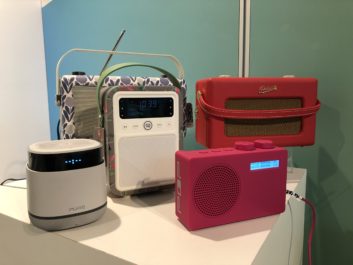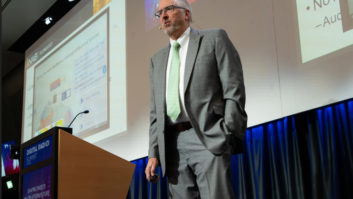OTTAWA — People from various areas of the industry are optimistic about radio’s fortunes in 2020, especially when it comes to “riding the digital wave.” But some of them see challenges in radio’s ability to attract and hold younger listeners, who must be won over to keep this audio medium viable for decades to come.

CONTINUED GROWTH FOR DAB+
Let’s start with the most positive radio trend in 2020: DAB/DAB+ will continue to grow in reach, usage and popularity.
“We expect to see continued growth of digital listening as audiences shift away from analog platforms,” said Aris Erdogdu, WorldDAB’s communications manager. “DAB/DAB+ will remain the dominant digital platform — especially in the car.”
A case in point: “In the United Kingdom, digital listening has increased to a new record of 56.8%, up from 52.4% in Q3 2018,” said Erdogdu. “What’s more, listening via DAB now accounts for 39.7% of all listening, and 70% of digital listening.”
“DAB digital radio is also prevailing in the automotive sector,” he added. “In the U.K., 93% of new cars now come equipped with DAB as standard, and DAB listening in the car has increased by 13.1 million hours — or 15.5% — compared to the same time last year.”
2020 will be a watershed year for in-car DAB, thanks to the European Union’s decision to require all new car radios in the EU to receive digital terrestrial radio by Dec. 20, 2020.
“Germany has recently transposed this directive into national legislation, while Italy and France — which is preparing the launch of its national DAB+ network in 2020 — already have laws in place which conform to the EU rule,” said Erdogdu.
DAB/DAB+ is attracting attention in other parts of the world including the Middle East, North and South Africa as well as Southeast Asia. “Tunisia is the latest country to have rolled out DAB+, and neighboring Algeria has also hit the ground running with the launch of a DAB+ trial in and around the capital Algiers,” Erdogdu said.

DAB+ is also gaining ground in Australia. “Permanent commercial DAB+ services were launched in the cities of Canberra, Darwin and Hobart in 2019, so there are now eight major population centers in Australia with DAB+, and more regional areas will follow next year,” said Joan Warner, chief executive officer of Commercial Radio Australia (CRA).
“DAB+ will grow as commercial networks are offering more DAB+-only stations and enhancing and rebranding their services,” she noted. “For instance, Southern Cross
Austereo is now offering five DAB+-only stations under their Triple M brand — Triple M Greatest Hits, Triple M Classic Rock, Triple M Aussie, Triple M Country and Triple M Hard N Heavy. Listeners have more music choice to fit their mood, while advertisers can access incremental audience reach beyond the main Triple M station.”

DAB/DAB+ offers business opportunities for smaller broadcasters such as the U.K.’s Angel Radio. It is a community radio station serving listeners 60 years and older via FM, regional DAB and web streaming.
“Since 2015, Angel Radio has run one of the trial small-scale DAB multiplexes,” said Tony Smith, founder and station manager of Angel Radio.

“We currently bring 28 radio services to DAB+ listeners in the Portsmouth, Gosport and Havant areas. These stations are mainly small internet-only or FM community stations that could not afford the cost of carriage on regional DAB. Our multiplex carriage rate card is flexible enough to enable larger, more financially stable stations, to subsidize the cost of carriage for much smaller niche stations.”
SMART SPEAKERS ARE GOOD FOR RADIO,
In April 2019, the technology research firm Canalsys predicted that the number of web-connected smart speakers in use worldwide would increase 82.4% from 114 million units in 2018 to 207.9 million units in 2019. Given the proven popularity of smart speakers such as the Amazon Alexa/Echo, Google Home, Apple HomePod, and the Sonos One, this trend seems likely to continue in 2020.

Radio is tagging along for the smart speaker ride: “The use of smart speakers to listen to the radio more than doubled in the past year,” said James Cridland, radio futurologist and editor of the Podnews newsletter. “Live radio is the most popular audio consumed on smart speakers, by total time spent listening, and it seems that these devices will continue to replace broadcast receivers in more households.”
It isn’t just Millennials who listen to radio via smart speakers. “Alexa is definitely being used more by our older audience these days,” said Angel Radio’s Tony Smith. “Around 15% of our U.K. online audience is using Alexa and Echo Dot.”
“The future seems to be the net aided by smart speakers, laptops, smart phones and apps,” said Peter Moore, owner of Radio Caroline, the one-time ship-based pirate broadcaster that is now a legal terrestrial radio station on AM/MW, DAB and the web. “Our online audience has now increased 45-fold whereas our satellite audience was at best static and that while we extensively use local DAB, this is just a novelty that we hope may develop in the future.”

PODCASTING GAINING GROUND
Podcasting is a trend that radio people are talking about, with many broadcasters jumping into the medium to stake out new territory and attract new listeners.
A case in point: In 2020, “there will be a strong focus on podcasting as we’ve recently launched the Australian Podcast Ranker, which will be a regular monthly report of the top 100 most downloaded and listened to podcasts in Australia,” said Commercial Radio Australia’s Joan Warner.
“The aim is to drive consumer awareness of the great variety of content out there and increase advertiser understanding of the opportunities in the podcast space. The latest Australian Share of Audio study by GfK showed that consumers are now spending more time listening to podcasts than owned music.”

WINNING YOUNGER LISTENERS REMAINS A CHALLENGE
One negative trend that appears likely to continue in 2020 is broadcast radio’s weakening appeal to younger listeners.
“While radio continues to reach 9 out of 10 adults in most countries across the world, it appears to be losing its gloss with young audiences who are listening for considerably less time,” said Cridland. “Radio is increasingly relying on an aging population to continue delivering their audience figures. Younger audiences, who increasingly look for on-demand content, needs to be a focus for the industry.”
To turn this situation around, “Radio needs programming to attract younger audiences, and we need radio to understand that ‘live and local’ is much less compelling for younger audiences than ‘real and relevant — real people on their air, with relevant content for them,” he said.
“This is a real challenge to radio’s long-term future, and I’m increasingly concerned that radio broadcasters are complacently using their current audience figures as an excuse not to change.”












